Posted: August 11, 2015 | Author: ruthgreenspanbell | Filed under: Uncategorized |
by Anne Rollins
Recycling is in the news lately. Two recent articles in the Washington Post highlight the problems local governments face: “A Greener Nation Puts Recyclers, Cities in the Red” and “Cities, Counties Come to Grips With Recycling Cost.”
Over the past few decades recycling has become almost routine, and our local governments and institutions have regularly made it simpler for us. In Washington, residential recycling went from open green bins to today’s large, covered blue cans and single-stream collection.
But a constantly-changing market for recycled materials is seriously complicating an act that once seemed pretty straightforward, making it far more costly for local governments to dispose of now-unwanted waste. And it would seem that, in our enthusiasm for recycling, we are filling our bins not wisely and too well, with too much that shouldn’t be there.
The Department of Public Works sends illustrated flyers to inform residents of what they can and cannot recycle, but most of us take for granted that we can toss in anything glass, metal, plastics, paper and cardboard.
A closer look at one of those flyers or the poster on the DPW’s website reveals that it’s not that simple.

I noticed, for example, that DPW does not want the lightweight, clear plastic clamshells that so many fruits and vegetables such as berries, lettuce, and cherry tomatoes come in, though they are clearly marked with the #1 recycling triangle.
So I sent an email to DPW asking about that and received an informative reply from “LR” at the Customer Service Clearinghouse. The problem with those plastic containers – and, it turns out, other materials – is both technological and economic.
Single-stream recycling is convenient for residents, but that stream has to be sorted at the recycling center. The sorting process is largely mechanized but also done partly by hand, and any undesirable material that has to be picked out or slips through to pollute other materials is costly to the city.
The desirability of any material is based on the market for it, and at the moment there is little or no demand for the plastic in the clear clamshells, and it cannot be mixed with other plastics.
But what about that #1 recycling triangle? According to LR:
“Contrary to public perception, the numbered triangle does not indicate recyclability nor recycled content. It is a system that was started in the late 80s to assist the recycling industry and has been appropriated in public perception for ‘green’ attributes or other recycling information. Items manufactured via different chemistries may both bear the same number, but they cannot necessarily be recycled together, thus the numbering system is not useful as a primary means to identify recyclability…. Your recycling collector (in this case the DC government) can tell you what can be recycled at your property. Residents using the… blue cart can recycle plastic bottles (regardless of numbers), and any rigid plastics…. You should not attempt to recycle ‘soft’ plastic items like cups, clamshells, produce containers… electronics packaging, polystyrene… these are all unacceptable, regardless of number.”
In a follow-up phone call, William Easley, recycling program officer at the DPW, further clarified that even plastics within the same number category such as #1 can have different compositions and consistencies. Each of these may melt or break down at different temperatures, which can mess up the recycling process if they are mixed together.
And as the articles in the Post make clear, what started out as a modestly profitable service for the city has turned into an increasing expense. Part of this, of course, is the result of shifting markets for recycled materials. The demand for newsprint has fallen, for example, as readers move online.
But we recyclers must also pay more attention to what we toss in the blue cans. According to Mr. Easley, the contamination rate of the recycling stream since we received the new, larger blue cans has gone from 5% to 10%, and that is costing the District a lot of money and more than a few headaches.
Checking the DPW’s flyers or poster can answer a lot of questions about what to recycle, though the sheer variety and number of plastic items seem to defy simple description. What about take-out containers from the deli counters at supermarkets?

No simple answer, according to Mr. Easley, who encourages us to call 202-645-7191 or emaildpw@dc.gov with questions about whether to recycle an item or not. If you are in doubt, however, and don’t want to wait for a reply from DPW, toss it in the trash. That may well be a “greener” act than adding something to the recycling stream that may only pollute it.
Here are a few simple things we can do to improve our recycling:
Know before you throw. Check items against the DPW’s list of what is acceptable; email or call DPW with questions; and put anything you are unsure about in the trash.
Keep it loose. Don’t put bottles, cans, newspapers, etc. in plastic bags to recycle. If you want to recycle plastic bags, bundle them in one plastic bag and tie it shut before dropping it in the can. Loose plastic bags cause many problems at recycling centers, where they often get tangled in machinery. Or, take the bags to a collection point at a supermarket, where they will be recycled at a facility designed for them.
Break it down. Flatten cardboard boxes and throw away any non-cardboard packaging materials from inside. Don’t recycle pizza boxes.
Ignore the numbers. Do not rely on the numbers in the recycling triangles to determine recyclability. Contrary to widespread popular belief, they are not intended as guides for consumers.
Posted: July 26, 2013 | Author: ruthgreenspanbell | Filed under: Uncategorized |
Even an organization or a company that wants to be an environmental leader must be persistent in its commitment. The following story is about one such company, determined to walk the walk, not just talk.
The Recycling Chronicles
Second Nature: Integrating Green Practices
I am the Chief Sustainability Officer (CSO) for a company that performs environmental consulting services and is itself an environmentally conscious company. When I stepped into this job, I knew that I’d have top management’s support, that our employees believe ardently in conservation, and that our environmental practices are time-tested and extensive. Don’t get me wrong. At no point do I mean to suggest that the job is a simple one.
As Kermit the Frog says: 
Being green is a journey, and success is more likely when the philosophy and support originate from the top. The other day I heard our company President relate a story about a seminal moment in the creation of her green management philosophy. Several years ago she attended a meeting at the headquarters of another environmental consulting firm where she noticed and applauded several innovative green practices. When she asked that company’s chief executive where the ideas for those practices came from and how they were being implemented, she received this response: “Oh! I’m not sure. You would have to ask our Chief Sustainability Officer – that’s his job.”
This is precisely the kind of thinking that creates an environmental silo, a place where only CSOs and their teams will venture. In the context of company reporting it may be sufficient to hire a CSO to make sure your company follows the rules – but it won’t do a thing for seeding and maturing a company’s green ethos or establishing its sustainable posture in the world.
So back to my comment about a journey. You might think that a company which has been using green practices for a number of years would have this stuff under its belt. Locked and loaded so to speak. Well mostly yes and sometimes no. Let’s begin by talking about the immutable law of the business world: change. In our case, we’ve experienced a period of rapid employee growth. Suddenly we’re no longer a small company where you know every face you pass in the hallways. These days there are lots of new faces around, people who come and go in concert with their travel schedules. So how do you make eco-practices second nature to a rapidly growing group of new employees? Let’s face it – identifying and instituting green practices may be a science, but putting them into practice and having them become second nature to an expanding workforce is more of an art. Here are highlights of some precepts that have worked for us. 
First: Start at the top
Grassroots networking is a great thing for political campaigns, but within a company structure there needs to be a clear and unequivocal message from the top: the company President. The occasional Facebook or Twitter post is not enough. Whatever the company’s green message is, it needs to be communicated regularly and broadly from the highest levels of the company – whether it be to social media, at conferences, in staff meetings, in think pieces, or via internal communiques. For example, when our company extends an employment contract to a potential employee, that contract includes a clause stipulating that the employee will be working on a conservation project for Earth Day each year. That’s a clear indication of the importance the company leader places on environmental action. You will also be directed to our company’s podcast series, where the company President interviews thought leaders on key environmental issues of the day.
Second: Make the information easily accessible and pervasive
Shortly after joining the company, you will be directed to an online policy manual that talks about our green purchasing philosophy; it includes a section about our intent to achieve the best dollar value as well as the best “green” value in any purchase or contract we undertake. Within your first three months, you’ll attend an orientation where we tell you more about our green philosophy. At that point you will also be given a tour of the resources available on our intranet site – including listings of green vendors and green supplies, copies of the Green Housekeeping Guides which speak to our green practices by location, and we’ll show you where you can submit green ideas online.
Then there are the “Breaking Bread” and “All Hands Staff Meetings” each month, where at least one segment is guaranteed to focus on a topic related to greening our business. Add to these the short articles in the company e-newsletter, and it’s hard to avoid noticing there’s a green culture at work (yes, the pun is intended). With the passage of time, you will also begin noticing that our Facebook and Twitter feeds carry updated environmental news on a daily basis.
Third: Involve everyone
While having a CSO may be inherently desirable, great ideas and change only happen when everyone is involved. Make sure whomever is leading your efforts has the ability to reach out across the company to involve people in all areas – HR, IT, Project teams – for green visioning. Within our company, shortly after you’re hired you’ll hear about something called the “Green Vision Council” – an ad hoc group of employees who either volunteer or are tapped by the company President to spend about an hour a month throughout a six month rotation to initiate and implement green ideas across the company.
The membership of this council changes every six months and is chaired by a different staff member each rotation. The idea is that employees from every area of the company – project managers to admins – will either get to chair or participate on the Council. It is a simple way to ensure that multiple perspectives are considered and that we don’t overlook an opportunity to green any nook or cranny of the firm. Because we have a lot of recent college grads in the company, we try to have at least a couple of them on the Green Vision Council, reasoning that coffee pot talk (i.e. the new water cooler) can go a long way toward spreading the word. We also encourage the Council to have at least two projects a year that will impact everyone. So when somebody shows up in your office asking if they can collect your recyclables to weigh them, chances are you’re going to ask what’s going on. And so the word and involvement spreads……. 
Fourth: Empower your staff
While this concept applies to everyone, it is especially true when you are adding new staff. Make sure that your employees (new employees especially) have not just the information, but also the right to be green in the office. We all know that being green can sometimes be more expensive. But once you’ve made the commitment, make sure people know that it’s okay to spend that extra amount. Even if they can’t use your centralized purchasing function (this is especially true if you’re located in a small one or two person office), they need to know that it’s ok to stop by the local Staples store to pick up some green supplies and charge them to their corporate card. Or when they need a bookcase for their office, let them know that our preferred vendors are local thrift shops and antique stores.
Fifth: Celebrate your success
Have a party or at least have some fun. Last year we tried something new – instead of having a holiday party, we had a “Green Gala” where the theme was for everything to be as sustainable as possible. We also hold a sustainable breakfast series where employees can munch donuts and coffee while exchanging ideas with local experts. And when we decided to write a climate action plan for our various sites, we took a staff meeting and let everyone brainstorm the impacts most likely to affect their location, and then drive the action planning around their choices.
Sixth: When it’s time, take the leap
When it comes down to measuring your progress, you will know when it’s time to go beyond an informal system and move forward into a more metrics-based compliance regime. When we were smaller, we could just look around and see where the company was making progress and where the gaps were. These days, we’re bigger and more geographically dispersed, and suddenly, we’re facing questions we can’t answer without a better tracking system, such as:
How many business miles per employee do we travel each year?
How many business miles per dollar of revenue?
What’s our carbon footprint for the space we occupy?
How many cubic feet of trash do we recycle each month?
How much energy usage do we need to offset each year?
How many trees have we planted as part of our Earth Day activities?
How many of our supply dollars go to green supplies each year?
How many energy and water reduction practices do we have in place at each office?

When this happens, pick the system that is best for your company. In our case, we went after the P391 – NSF International’s Sustainable Service Provider protocol, which sets out both mandatory and optional requirements for implementing and tracking sustainable practices. Once you begin to measure your practices, you realize two things. The first is that sometimes green practices require reinforcement. That happens when we see numbers trending in the wrong direction (e.g. why didn’t you use Skype to hold that one hour meeting with staff 50 miles away instead of driving up to be there in person?). The second lesson is that sometimes the numbers you do have are worthless. Case in point: Our current expense system won’t allow us to accurately segregate our spending on green supplies from non-green supplies without employees providing copious comments whenever they submit a voucher. Consequently, we’ll be enhancing that tracking system next month – making the process easier for everyone!
And so it goes. We come up with ideas, we road test them, we measure the results, we celebrate the ones that work, and go back to the drawing board for the ones that don’t. Each month we take a few steps forward and the occasional step back. We’re in the enviable position of having wholehearted management support for our efforts, and that sends a message to every employee that conservation matters. Walking the walk matters. And ultimately, we’re all trying to keep our eye on the ball and give it an extra push as needed. That’s how change happens – and we’re committed to the change.

Posted: March 29, 2013 | Author: ruthgreenspanbell | Filed under: Uncategorized |
As we are in one of the great seasons of eating – the Easter/Passover period — we wanted to follow up the last post about food waste with a post about not wasting food. This guest blogger has been dubbed the “leftover queen” by her husband. She works here at the Woodrow Wilson International Center for Scholars and tries her best to recycle and not waste food. She shares her home with two dogs and two cats. Here is her story (to see how professional chefs made feasts from dumpster ingredients follow this link):
It wasn’t supposed to be in our driveway, but it was.
A Peapod order [home delivery of food from a local, Washington, DC grocery store] containing six boxes was mistakenly left in our driveway while we were on vacation in the Dominican Republic. By the time we realized, the boxes had been sitting outside for a week.
After checking with Peapod, we were told that we could do whatever we wanted with the items. We also checked with our neighbor across the street, who the order was actually intended for. After confirming that she didn’t want any of the items (she had already called for a reorder), we brought everything into the house.
I think most people would have immediately thrown out all of the perishable items, since we are conditioned to believe that perishable items not refrigerated properly will spoil.
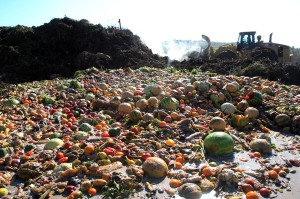
does this food really deserve to be sent to waste?
Instead, my husband and I took it at as challenge to see what could be saved.
I think we did a good job since we only tossed the frozen shrimp (which had defrosted entirely) and two bags of frozen vegetables.
In general, my husband and I try to be conscientious about not wasting food. Ironically, we had also done a fairly large grocery shop that morning (we were on our way to the store when we discovered the Peapod order, but at that point we weren’t sure what to do with it) so in some cases we actually ended up with almost identical items. In that case, we made it our first priority to use the Peapod food.
The canned goods and non-perishable items were obviously not an issue.
While we were a little skeptical about eating the perishable items, we were confident that everything had been kept cold (due to the abundant freezer packs and the relatively cool temperatures the area had experienced). So, over the next few weeks we proceeded to deep fry the chicken, cook the ground beef and steaks and consume the shredded cheese and large tub of sour cream.

Presentation is everything!
The two gallons of milk were our biggest challenge since that is far more milk than we consume. In the end we drank one and used the other gallon to make ricotta cheese.
In recounting our experience at a happy hour later in the week, one of our friends exclaimed, “Not the chicken”, when told that we had indeed cooked and eaten the chicken.
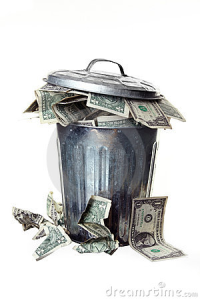
think of the money you will save
To see another creative use of waste (and some reflections on waste in historical perspective), go to this link
Posted: March 15, 2013 | Author: ruthgreenspanbell | Filed under: Uncategorized |
In the American land of plenty, disposal of food waste – and whether there is any productive use for that waste – is a frontier in the issues around recycling. For recycling of materials we ask, given the damage and cost of extracting resources from the earth, doesn’t it make sense to collect and reprocess them after their first use, rather than throw them away?
Food waste adds a complicated twist to these questions. In a world where many routinely go hungry (including in our own country), we also have the reality of high amounts of food waste. Like the other recycling, we should be addressing these issues on both the front and back end. Waste reduction by more careful planning might mean less spoiled food.
But how should we be handling the inevitable food waste (which includes waste from those parts of fruits and vegetables that we don’t use, as well as food we simply let go bad)? These materials have value –properly handled, they can be turned into fertilizer for gardens and farms, and can even be used to make renewable energy. And when they are not well handled, and food rots in a landfill, it releases methane, a greenhouse gas that is 23 times more potent at warming the atmosphere than carbon dioxide.
Our guest blogger is Laura Moreno, an Environmental Scientist in U. S. EPA, Pacific Southwest Region’s Office of Pollution Prevention and Solid Waste
“What will I make myself for lunch?”
“The lasagna last night was delicious. I must make that again!”
Thoughts of food invade many people’s heads throughout the day, thinking of their last meal, their next meal, or daydreaming about a delicious culinary escape from reality. Rarely in our daydreams and musings about food do we think about the amount of food we waste. Despite the significant and emotional role that food plays in our culture, Americans are throwing away more food and sending it to landfills than any time since 1960 (when EPA recording started)!
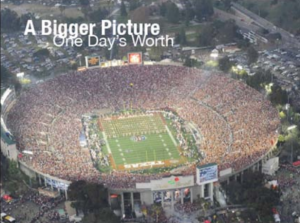 A half pound of food waste per person per day may not seem like a lot, but when you add it up, it adds up to 34 million tons of food being wasted each year in the United States (source: EPA MSW Characterization). How much is 34 million tons? Jonathan Bloom estimates that it is enough to fill the Rose Bowl Stadium to the brim with wasted food each day. We send more food to landfills than any other single material, including paper or plastic.
A half pound of food waste per person per day may not seem like a lot, but when you add it up, it adds up to 34 million tons of food being wasted each year in the United States (source: EPA MSW Characterization). How much is 34 million tons? Jonathan Bloom estimates that it is enough to fill the Rose Bowl Stadium to the brim with wasted food each day. We send more food to landfills than any other single material, including paper or plastic.
Why is wasting food bad for the environment?
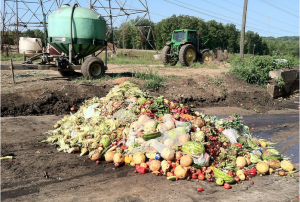
• Wasted food = Wasted resources! When you throw away a piece of chicken, you are also throwing away the water, energy, fertilizer, pesticide, and other resource inputs that went into making that plump and juicy chicken.
• 13% of greenhouse gas emissions in the United States are associated with the lifecycle of food, including from growing to manufacturing, packaging, transporting, and eventual disposal (source: EPA Opportunities to Reduce GHG Emissions through Materials and Land Management Practices).
• Wasted food ends up in landfills where it decomposes in the absence of oxygen to generate methane, a greenhouse gas 21 times more potent than carbon dioxide.
Why is wasting food bad for us?
Wasted food isn’t just an environmental issue. It’s an issue of equity and economics.
• We are throwing away a record amount of food, much of which is edible and safe to eat, while 50 million Americans are ”food insecure” meaning they don’t always have access to enough food to meet their needs (source: USDA). We should be feeding people, not landfills. Wasting food wastes money. USDA estimates that wasted food in the United States costs consumers and retailers $165 billion annually, equal to the GDP of Ukraine.
• According to the Natural Resources Defense Council, the average American family of 4 spends $1600/year on food it never eats.
As a consumer, what can I do?
As consumers, we have the capability to significantly reduce the amount of food that is sent to landfills. Here are a couple of ideas so you can take a stand against wasted food and save some money in the process:
1. Shop your refrigerator first – Before going to the store, look in your refrigerator, see what you already have, and plan your menu around those items.
2. Plan your menus before you go shopping – Before going to store, plan your menus so that you don’t buy more food than you need.
3. Know when food really goes bad – Most food products have a “best by” date. This is not an expiration date (except for infant formula), but a date to indicate when the food is at maximum quality. Learn more at http://switchboard.nrdc.org/blogs/dgunders/use-by_and_best-by_dates_a_myt.html
4. Eat or share your leftovers – Don’t want to have the same meal two days in a row? Be creative and use your leftovers to make new and exciting meals. For instance, leftover pasta from one night can be turned into a delicious pasta salad to accompany your sandwich at lunch. Or use your vegetable trimmings, such as the skin or ends, to make a delicious vegetable stock. If you don’t think that you can get use the leftovers in time, put them in airtight container and freeze them for later use.
5. Use every part of your food, if possible – Just like you can use every part of an animal, the same is true for many fruits and vegetables. For instance, many people chop off and throw away beet tops. But, they are actually delicious — and can be sautéed or cooked up like any other green such as spinach or collard greens.
6. Encourage your local businesses to donate fresh food to local food banks – Do you know if your local grocers, restaurants, or other businesses donate their untouched, but edible food to local food banks? If not, ask them if they do and encourage them to start a food donation program.
(Note: People often worry about liability when donating food. Worry not. The Bill Emerson Good Samaritan Act, a Federal law, protects donors from liability if they donate food in good faith and follow food safety rules.)
7. Compost your food scraps – Some cities collect your food scraps along with other recyclables and trash. If you don’t have that option, you can start your own compost pile in your backyard) or a worm composting system if you don’t have a backyard.
Posted: December 11, 2012 | Author: ruthgreenspanbell | Filed under: Uncategorized |
Jennifer Anduha, Managing Director of Office Service at a large, Washington-DC based international law firm, is the first guest blogger for the Recycling Chronicles. Here is her story:
Even big international law firms, and even lawyers, care about the environment- most care very much and I know this because I have seen the firm, that I work for grow an environmental program from nothing in 2008 to a robust and dynamic part of the firm’s culture in just 4 years. As one of several careers that I have embarked, law firm management is the most challenging and by far the most rewarding. I have been able to apply skills learned in the hotel and the executive suite business to my job- mostly how to multi-task, manage people, and keep a sense of humor at all times!
I never thought I would become the “green guru” as my boss likes to call me. Other than recycling my water bottles and newspapers at home, I came into co-chairing our firms’ Green Committee with very little knowledge about good business environmental practices (other than common sense) and what initiatives should be implemented.
Then there was the added challenge of trying to identify those staff and attorneys in the firm that were passionate (or at least mildly interested and intrigued to commit the time to become part of a formalized committee) and doing it all without a budget. It has been an incredible learning experience so far!
We have approximately 500 lawyers just in DC and worldwide our lawyer count approaches 2,400. We operate out of over 40 offices across the US and abroad, including Asia, Europe, Middle East, and South America.
Culturally there are varying degrees of participation in firm environmental programs across the globe with our US and European offices being more involved and experienced overall than our Asian offices. But there is certainly a level of engagement in all offices and the Environment has become a cornerstone of our firm culture.
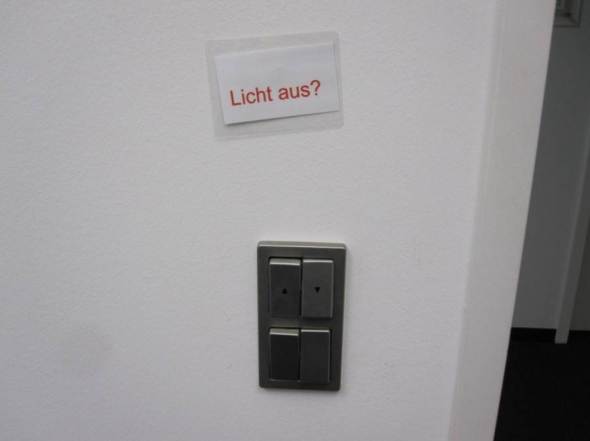
turn out the lights sign in German law office
In the last couple years we have seen an uptick in the number of potential clients that specifically ask, as part of the bidding process, about our environmental programs- this definitely got the attention of our attorneys. I feel that the driving force for this, in most organizations, is that it is the right thing to do in a society so entrenched in consumerism and the waste that goes along with it. Organizations then expect to do business with and partner with vendors and professional services firms that share the “it’s the right thing” philosophy.
The first “green” committee was formed in August of 2008 and consisted of lawyers, managers, and support staff across the firm’s US offices. The committee’s initial goals were to understand how all the offices recycled (if they recycled) and how we could work together to promote reducing our carbon footprint.
We were successful! In the 4 years since, all of the US offices recycle on some level and most recycle everything- paper, cans, glass and plastic. We encourage recycling by providing desk side bins, centrally located bins in copy rooms, pantry areas (see example below),

Pantry area recycling bins
large departments, and conference rooms.
I thought that putting recycling in the conference rooms would meet with some resistance, but I feel it is quite the opposite. Attorneys and staff using these rooms find it convenient (as those really good citizens were taking empty plastic bottles with them to recycle) and visitors can see that we practice what we preach. In all of our new construction we are incorporating slide out recycle bins in all conference rooms.
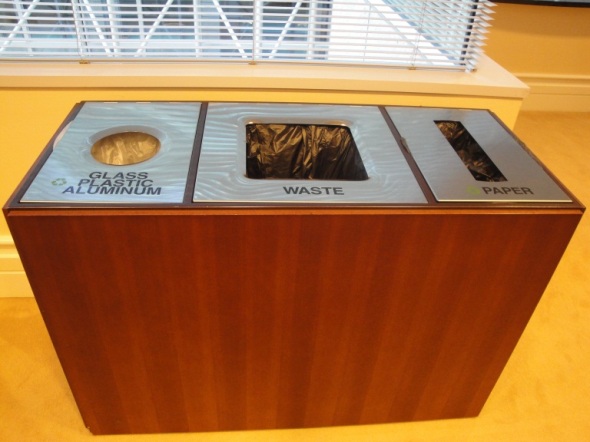
conference room recycling bin
We post information in our cafeteria with examples of items that are recyclable or compostable.

recycling examples posted in cafeteria of major international law firm
We instituted the use of an email signature, “to consider the environment before you print”, tag line 2 years ago; and we partner with our building each spring for an informative Earth Day event in our lobby.

Earth Day Recycling event
The firm has a robust e-waste program and recycles approx. 50,000 pounds of electronic waste per year.
We pursue LEED certification through the US Green Building Council in all of our new office build out projects (and two of our projects have been awarded LEED Silver status in the last 3 years, and we are working on 2 more in the next 15 months.
The firm has made the cultural switch to default all high speed copiers and printers to double sided- and I have to say the push back was a minuscule blip on the radar so all in all very successful!
The newest challenge we face is trying to actually quantify our results. How much are we recycling; how much paper are we saving every year; what is the resulting save to our planet and OUR impact on OUR carbon footprint? Fortunately, law firms understand that our clients want to know and our clients are asking therefore, slowly support for calculating and organizing this information is coming to fruition through organizations like the Legal Sector Alliance in the UK and the newly forming Law Firm Sustainability Network in the US: http://www.ecoanalyze.com/resources/LawFirmSustainabilityNetwork.aspx
On a personal level and to give the reader an idea of how wasteful we really are (and most of us are to a fault); I suggest doing the carbon footprint quiz. We did this a couple years during out Earth Day event and it was eye opening- and fun. Here is the link: http://www.myfootprint.org/en/visitor_information
I was particularly interested that the firm located recycling bins in its elegant conference rooms. I have heard concerns elsewhere (including here at Wilson Center) that outside visitors to meetings might be offended by recycling bins. Apparently, however, it is a business plus.
Posted: November 13, 2012 | Author: ruthgreenspanbell | Filed under: Uncategorized |
Some buildings ask you to separate your recycling into paper, bottles and cans. Others have a single bin. Doesn’t co-mingling make recyclables into trash? Chris Philpot did a great graphic for the Washingtonian Magazine, which we copy here with permission, explaining how it all gets sorted out (thanks to Thomas White of the Magazine for allowing us to blog it).

Posted: October 22, 2012 | Author: ruthgreenspanbell | Filed under: Uncategorized |
In posts 1-6, I explained our recycling goals here at the Wilson Center, and some of the challenges we encountered.
Today, we propose to get slightly more analytic and compare what we learned to some of the academic literature. Schultz, Oskamp and Mainieri’s 1995 literature review consolidated what has been learned about recycling. Some of it is a bit old, but it’s not so far off.
Here is a brief report, supplemented a bit with our own Woodrow Wilson Center experience.
- Barriers make a difference. If it’s a nuisance to recycle, most people just are not going to do it. Nuisances include it doesn’t pay, it’s just too much trouble, or it is too messy. Location and proximity also are important. If you have to get in the car and take things to the recycling center, few people will be motivated. Most cities have fixed this problem by providing curbside recycling.
But, to digress for a moment: remember back in 1967, Arlo Guthrie’s immortal tale of his arrest for illegally dumping post-Thanksgiving rubbish after discovering that the Stockbridge, Massachusetts town dump was closed for the holiday. Arlo was motivated to truck his trash but he hit one barrier too much.

Just to remind, here is the whole story:
Eighteen year old Arlo and his friend pleaded guilty before a blind judge, were fined $50 and told to pick up their garbage. But not before Arlo was introduced to some of the absurdities of siccing the criminal justice system on teenagers trying to get rid of trash. The arresting officer was prepared to present “27 8×10 color glossy pictures with circles and arrows and a paragraph on the back of each one explaining what each one was to be used as evidence against us.”
Having to transport your trash is definitely not motivating for people otherwise indifferent to recycling or those who are just plain busy.
Proximity might even be important on a smaller scale. At Wilson Center, some people were throwing their trash in the first available bin. If we switched the position of the recycle bin so it was a bit closer to an office door, we noticed that recycle materials magically found their way into the correct bin.

- Knowledge is important. It may not surprise you to know that experienced recyclers have significantly more knowledge about recycling than non-recyclers. They have a pretty good sense of what can and cannot be recycled. This knowledge gives them a sense of confidence that guides their actions.
We saw that here at Wilson Center, both positively and negatively. It is very helpful to know the rules. But sometimes, knowing the rules can be counterproductive. What if the rules are different in your office and your apartment building, or between your old office building and the new one?

People may be justifiably confused because their city or county recycles one way and their office space, another. People may bring knowledge that was valid a few years ago, but has been superseded. And because recycling isn’t their highest daily priority, it is unlikely most people will take the time to update all this confusing information and act accordingly.
- Demographics: Schultz’s 1995 review of the literature review found that people with the highest levels of environmental concern tended to be young, more educated, urban, and liberal in ideology. However, Hilary Nixon and Jean-Daniel M. Saphores reported on a 2008 survey that, while age and ethnicity are statistically significant, income or education are not. All we can say is: go figure….
- Personality variables: interestingly, the research suggests that recyclers are people who tend to believe that they can determine their own destinies. Apparently, these are take-charge as opposed to passive people.
- What about interventions and situational factors?
- Prompting, whether it is through a brochure, newspaper ads or oral pleas, was found to be effective, to a point.
- But, it is more effective to combine prompts with proximity. So, post your guide to recycling above the recycling bin. Use communication tools to connect with people but also minimize how much effort they must expend to follow through. And try to avoid the kinds of frustration people feel when things don’t work. Think about Arlo Guthrie’s famous song, and plan curbside, not drop-off.
If people are required to sort their recycling, is that enough burden to discourage the activity? According to Schultz, Oskamp and Mainieri, the research is unclear.
- Eliciting commitments and other kinds of interventions. When people make a commitment, they are more likely to follow through. Commitments can be oral or written; they can be public or private; they can be made as a group or individually.
Interestingly, this approach is being picked up in other contexts. When I recently did some political canvassing, the campaign was asking committed voters to sign an informal pledge to remember to vote.
- Social norms. It does make a difference if your friends and neighbors recycle — that means you are more likely to do so. Why? If you are the only person recycling, it’s hard to believe your lone action can make a difference. Working as a community, in groups and with leaders (whether in blocks, floors or hallways), gives me a higher degree of confidence in ultimate results. And, everyone wants to feel like part of some community and is likely to at least consider doing what the community expects.

- Goal setting. Schultz, Oskamp and Mainieri reported that cities that established a recycling goal (say, a percentage of total waste stream) reported “significantly” higher levels of citizen participation than cities without such goals. This was true also in an elementary school elementary school and a college. The researchers did not know whether the recycling behavior persisted beyond the period of goal setting.
- What about rewards, especially monetary rewards? Here is where things get really interesting.
Contrary to what we all assume will motivate people, there is some evidence rewards can be counter-productive. Schultz, Oskamp and Mainieri quote research on “over-justification effects”. This is the phrase social psychologists use to explain that offering external incentives (for example, money or prizes) for a previously unrewarded activity undermines internal motivation. Sadly, when rewards are ended, people often lose interest in the activity. Worse yet, prior intrinsic motivation does not return. Once set in motion, extrinsic rewards must be continuously offered as motivation to sustain the activity.
 A 2010 paper by Rensselaer Polytechnic Institute economist, John Gowdy, mined some tantalizing research.
A 2010 paper by Rensselaer Polytechnic Institute economist, John Gowdy, mined some tantalizing research.
- As noted above, monetary incentives can “crowd out”pro-social behavior. When people are paid to donate blood, for example, contributions drop sharply.
- Gowdy cites another study in which the brain activity of two male players receiving a substantial monetary reward for correctly estimating the number of dots on a computer screen was scanned. As expected the ventral striatum (a part of the brain associated with reward) was activated when the participants received payment for a good guess. Surprisingly, the reward system was substantially more active when participants were told that the other player was unsuccessful.
- Gowdy cites still other experiments suggesting that although both men and women are motivated by anticipation of both monetary and social rewards, women are more responsive to social rewards than are men.
What are the lessons from this?
- make it clear (what goes where, how)
- make it simple (all in one bin is good, saves space in homes)
- make it easy
- make it a habit

In the next Recycling Chronicles, we will hear from the facilities manager of a larger international law firm — what they have learned about recycling, environmental stewardship and client relationships. And still later, we will talk about what all this says about human capacity to manage other environmental challenges including the biggest of all, climate change.
Posted: October 2, 2012 | Author: ruthgreenspanbell | Filed under: Uncategorized |
After non-productive venting with interns who dropped aluminum cans in the trash, I tried to channel frustration, rather than express it.
Here was the plan: After some negotiation with management – they were worried about aesthetics in a building that draws daily visitors including often Ambassadors and world leaders – it was agreed that we would put a poster in a non-public part of the Wilson Center dining room. The wall is directly next to the place where daily users of the dining room bus their dishes for cleaning. It is an area that would never be seen during an official Wilson Center function.
The poster would have actual physical examples of what can and should be recycled. A picture is below – items included plastics of various kinds including water bottles, knives and forks, take-away lunch containers, bags and temporary use plates; aluminum cans; and waste paper small and large – for example, paper packaging for single-use tea bags). The arrow at the bottom of the poster pointed to the recycle bin. We would put photographs of the poster in the smaller kitchens on the 3rd and 4th floor.
Physical examples proved to be useful when Ruth did her Wilson Center town hall presentation, and – frankly – it was an idea we stole from a major law firm located a few blocks from Wilson Center. In their dining room, for everyone to see, is a demonstration poster. Here is ours:

We accompanied the installation of the poster with another outreach email to the entire Wilson Center community. The challenge became: how to word another email to get people’s attention – and to maximize the chances a large number of people would open it; how not look like a scold; and, how to get the message out.
To show how this notice evolved, below is the first version. Note the image of money thrown in a trash can. And note the fairly dull, uninspired prose Ruth offered.

Just a reminder that high value recycle material can all be deposited in the same blue recycle bins.
- empty plastic and glass bottles and aluminum cans;
- envelopes including with some level of plastic;
- notebooks with metal spirals holding them together;
- books;
- magazines;
- paper of any color;
- the paper bag that you carry your lunch in or that Starbucks give you to carry your cookie out of the store;
- scrap paper (the paper that held your tea bag, for example, and post-its);
- cardboard
Your small recycling gesture helps support the building’s day care. If you have questions about particular items, either see the board in the service area of the dining room or check with Ruth
Recognizing how boring and dry this was, we then enlisted a WWC staff member with a proven track record of sending staff emails that are actually opened. His subject line is always amusing, and usually only very tangentially related to the subject matter in the email text. We asked Michael for a smoother, more compelling text.
With Michael’s help, here is the next version.

Unless you planned to give your local garbage collector a generous tip, you probably would not do this.
But when we place high-value recycle material in the trash, we are effectively throwing money away.
High-value recycle material can all be deposited in the same blue recycle bins. This includes:
- empty plastic and glass bottles and aluminum cans;
- envelopes including with some level of plastic;
- notebooks with metal spirals holding them together;
- books;
- magazines;
- paper of any color;
- the paper bag that you carry your lunch in or that Starbucks give you to carry your cookie out of the store;
- scrap paper (the paper that held your tea bag, for example, and post-its);
- cardboard
And remember that your small recycling gesture helps support the Reagan Building’s day care.
Questions about particular items? See the board in the service area of the dining room or check with Ruth.
Subject lines we are thinking about: “free food,” and “lose something lately?”
Our question: will a spoon full of sugar make the medicine go down? Stay tuned.
Posted: September 10, 2012 | Author: ruthgreenspanbell | Filed under: Uncategorized |
Although I never expected 100% recycling, the results we were getting were frustrating. And my concern grew when I saw building-wide results (results from the whole Reagan Building complex, not just the Wilson Center).
I’ve copied below the essence of the report. The bottom line was: this mixed-use building (it houses offices, meeting sites and a food court that attracts tourists as well as office workers) could do a lot better.
The report set goals of increasing recycling by an additional 10% by September 2012 to 26.5%. 26.5% is less than what EPA reports as the national average, 34.1% for 2011.
| Table 18: Observations and Recommendations |
|
Issue
|
From the waste audit, the audit team found that of the 330.4 lb representative sample of trash sorted, 117.3 lb or 36% of it was actually trash. 34% was composed of various recyclable materials. |
|
Recommendation
|
The facility should improve its collection of paper, PET #1, and glass found in the waste stream. Property management should increase communication and awareness of the facility’s recycling program through various methods, such as improved signs, notices, and training. |
|
Projected Outcome
|
Increased recycling will lead to a higher waste diversion rate. |
|
Goal
|
Increase diversion rate by an additional 10% by September 2012 to 26.5%. |
| |
|
Issue
|
Assuming 27% of each day’s waste stream that goes to the compactor is comprised of paper, this would accumulate to approximately 166.77 tons a year. If this paper were all recycled, the diversion rate for the facility would be 33% instead of the current 16.5%. Given the range of $30-$65/ton for mixed paper, this would generate an extra $5,003.10-$10,840.05 of revenue annually. |
|
Recommendation
|
Ensure all tenants have paper recycling bins that are easily accessible and trash bins are eliminated from areas where only paper is generated. |
|
Projected Outcome
|
Higher percentage of paper being recycled and more revenue being acquired. |
|
Goal
|
Increase diversion rate by 15% while increasing revenue from recycling by $5,000 annually. |
|
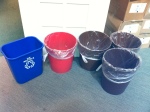
|

|
|
REALITY
|
IDEAL
|
The report also pointed out various mechanical, but important challenges to effective recycling. For example, there were problems with collection of co-mingled containers and with the efficiency of pick-ups (compactors could have been better utilized to reduce the number of actual pick-ups). Since food waste constituted an imposing almost one-third of the waste stream, the report recommended investigating off-site composting.
| |
|
Issue
|
In recycling report provided by the recycling coordinator for this region, no commingled container tonnages are ever recorded for this facility. |
|
Recommendation
|
Ensure commingled containers are being collected as recycling vendor demands and are recorded properly. |
|
Projected Outcome
|
Higher and more accurate diversion rate due to better data capture. |
|
Goal
|
Increase diversion rate by an additional 5% by September 2012 to 21.5%. |
| |
|
Issue
|
The current solid waste service utilizes a 34 cy compactor serviced on schedule three times a week. The average payload of the compactor is 3.86 tons per load. Compactors of this size servicing general office buildings can experience average payloads of 6-7 tons or more per load. The compactor is being over-serviced. |
|
Recommendation
|
Change the compactor to an on-call service when full. |
|
Projected Outcome
|
Assuming the compactor can achieve an average payload when full of 6 tons, the number of pulls would be reduced to about 98 instead of the current 151. Annual savings would be $6,625 savings. |
|
Goal
|
Reduced service with annual savings of $6,625 savings. |
| |
|
Issue
|
Food waste constituted 31% of the waste stream. |
|
Recommendation
|
Investigate food waste treatment solutions including off-site compost or on-site treatment of the food waste to save money and increase diversion. |
|
Projected Outcome
|
Food waste treatment either through off-site composting or an on-site system. |
|
Goal
|
Increase diversion rate by an additional 20% by September 2013 to 36.5% diversion. |
Perhaps I was primed by this report, but — I had a small temper tantrum when I saw aluminum cans in waste bins in the area where Wilson Center interns work, as I walked over to get my printing.
Aluminum is the highest value recycling material and there should be nothing ambiguous about whether aluminum can be recycled! How could young people, undergraduates who presumably were taught to recycle from a very young age, do this?
This led to an email to interns which, while not ballistic, probably was intemperate.

(c) <a href=’http://www.123rf.com’>123RF Stock Photos</a>
It read:
Of all people here, you should be the folks who do the best job of recycling. You are young. You have been taught this all your lives. And it matters for your future.
But when I walk to the printer, I find all sorts of valuable materials in the waste baskets – not in the recycle bins. Today is was aluminum cans; the day before it was glass bottles.
Recycling scrap aluminum requires only 5% of the energy used to make new aluminum.
How can I convince all of you to take a moment and move your hand toward the blue recycle bin? I attach a photo of a board in the dining room of a very fancy law firm up the street, showing people what can be recycled. We hope soon to install similar boards here at Wilson Center.
Please give me feedback. The project that brought me to Wilson Center is an effort to use demonstrate how to make social science research actionable in specific domains, such as its potential for improving efficiency commitments and developing smarter ways to resolve the many behavioral obstacles to energy efficiency. I want to hear from you about what you think will persuade you to make that extra recycling effort.
Ruth
Some say that shame is a behavioral motivator, but I am not sure this message produced that result. For one thing, it was essentially a private message to each intern. It didn’t create public exposure and disapproval in the way, for example, huddled smokers in designated smoking areas might. I didn’t get a single response; and no wonder –. I don’t think it motivated any change, but I also had no metric beyond personally watching the trash and recycling bins.
So, back again, to the drawing board, which is the subject of the next post.
Posted: August 24, 2012 | Author: ruthgreenspanbell | Filed under: Uncategorized |
Our appeal to recycle to support the cute babies in our building’s day care moved some people but not enough. We go back to the drawing board.

About a month later, we tried a different tactic.
Wilson Center hosts periodic town hall meetings for its regular staff (the considerable numbers of visiting scholars are not invited, nor are interns). In an effort to liven up meetings that are sometimes boring and sometimes a big downer, Wilson Center decided to invite to each meeting a scholar to talk about his or her research.
I was asked to be the town meeting guinea pig, to talk about the project that brought me to Wilson Center.
Just to repeat for those new to this blog: with Elke Weber at Columbia, I co-head a project to demonstrate how social science research insights can be put to work to change behavior in ways that will reduce greenhouse gas emissions. We aim to demonstrate the potential for improving efficiency commitments and developing smarter ways to resolve the many behavioral obstacles to energy efficiency and carbon reduction. Recycling – its human challenges – is our learning effort in our own Woodrow Wilson Center back yard.
I took that as an invitation to talk about the behavioral-human dimension of recycling right here at Wilson Center.

At the meeting, my assistant, Elizabeth, helped me display concrete examples of what can and cannot be recycled. We held up bottles and cans, cardboard, magazines, the small envelopes that tea bags are wrapped in, candy wrappers without food residue (turns out, we were wrong about candy wrappers), plastic forks and paper bags.
Here is our handout (later, we left one in everyone’s mailbox):
|
Recycling at the Wilson Center
|
|
RECYCLABLE
|
NON-RECYCLABLE
|
 |
 |
| Glass and plastic bottles and cans |
Plastics with food debris |
| Paper, all colors, staples, paperclips |
Facial tissues, napkins |
| Manila folders, envelopes |
Excess amounts of metal |
| Magazines, books, newspapers |
|
| Cardboard |
|
Concrete examples were a big hit. There were a lot of questions asked and concerns expressed, both in the meeting and in emails afterwards.
We learned that many people had out of date information that discouraged recycling.
- It was commonly believed that staples or paperclips must be removed.
- Some people thought only white paper could be recycled, not colored. Nor could books and magazines.
- Co-mingling caused confusion. How could clean paper go into the same bin with a used aluminum can? Or with a paper bag that once held a cookie? Or with a plastic fork?
Perhaps most interesting, a Wilson Center urban myth circulated that when recycle material got to the loading dock, it was simply dumped into the trash and hauled away. I can only surmise that this suspicion is rooted in misunderstandings about comingled waste. If very different kinds of waste are thrown into the same receptacle, it seems that people’s instincts are that the contents are treated like trash.
There was a great deal of relief when Elizabeth went to the loading dock and verified that recycling does go to recycling.
We thought our answers would be enough to update people and this would improve implementation.
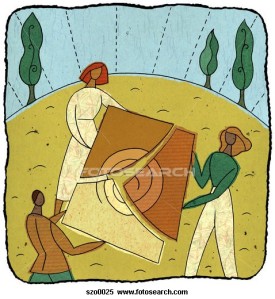
The overall reaction to the town hall approach was positive. People were thankful to get updated information and eager to ask specific recycling questions. A lot of people said it was “about time.” A few people expressed interest in a field trip to a recycling center (I had described the Rube-Goldberg-looking system that separates items out by weight and by other physical qualities, using magnets, gravity and other devices). Many people thanked us for our efforts.
But what did people hear?

A couple of weeks later, I got an email from a Wilson Center colleague. He asked:
Post-it notes – can we recycle them or does the glue on the one side make them invalid?
Paper – if we have something that is stapled together do you need to remove the staples or can you just leave them in there?
So — what do I take from this?
People are busy. They carry a set of rules and images in their heads. With paradigms in their heads, re-setting those defaults is very difficult.
The rules of recycling have changed (and will continue to change) and, different buildings have different rules. In the early days, recyclers accepted only white paper, no metal. Today, colored paper, stapes and a limited amount of metal is acceptable. What your office building recycles may be different from the rules at your apartment. Very few of us will stay current with the rules. Even if we are informed about the changes, those changes may not register enough to change our habits.
Mental images are important to how people act. People are confronted with a variety of receptacles for recycling. WWC has some for specialized recycling and other bins that accept any and all recyclable materials.

For the latter, everything is thrown into the same bin along with empty soda cans.

This is massively confusing. It seems to suggest, on the one hand, that recycling waste must be separated; and, on the other hand, that no separation is necessary. Which rule is correct?
And the difficulty in shifting paradigms is particularly hard when the change in question has little or no priority for most people. Shifts are especially challenging for busy people meeting daily deadlines.
Stay tuned for what we did next.




































